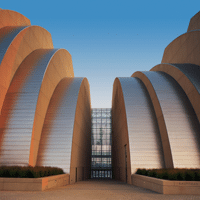For most new musical artists, performing in a garage is part of the deal before making it big. But performers at the Kauffman Center for the Performing Arts in Kansas City, Missouri, already have record deals and international tours, and they’re still performing at a garage—technically on top of one.
As part of the new Kauffman Center project, landscape architecture firm Reed Hilderbrand designed a public space above an underground parking area that functions as a gathering space and a place for concerts, outdoor performances, and even parties. In sum, the building and surrounding site encompass an entire city block. “From the beginning, the donor for the performing arts center had a vision that this was meant to be a very public landscape,” says Eric Kramer, a principal at Reed Hilderbrand.

Architect Moshe Safdie’s eye-catching performing arts center is surrounded by a landscape of fescue and Reveille, interspersed with paths that create a new neighborhood thoroughfare. Photos: Timothy Hursley

The green space above Kauffman’s parking garage used 300,000 pieces of expanded polystyrene, 3,000 tons of sand, and 100,000 square feet of sod.
One of only two firms chosen to work on both halves of the project—the north half focused on the center itself, while the south half included the garage and public space—Reed Hilderbrand, based in Watertown, Massachusetts, served as landscape architect for the entire endeavor. Kansas City’s Jeffrey L. Bruce & Company—the other firm involved for both parts of the Kauffman Center—was asked to provide preliminary consulting services on the project. “In many ways that was logical, because of course the landscape as a whole is the one thing that needed to be consistent across the entire city block,” Kramer says. The rooftop green space flows from the underground parking structure to the main structure, and it unites the project into a single landscape.
Managing storm-water above the parking garage is one of the primary functions of the public green space, but it isn’t its only purpose. “Unlike a lot of green roofs that store water, this one is entirely occupiable,” Kramer explains. The space is turfed, with a few trees scattered for shade and texture. Below that are six inches of a highly specified soil-and-sand mixture that also includes geofibers. “They act almost like roots,” Kramer says. “They hold the soil together so you don’t get any erosion, and they allow the soil to withstand compaction.”
When rain hits the grass, it flows through the soil and sand, slowly emerging onto a drainage board below where it is directed to a series of cisterns. The water is now clean, having gone through this highly effective and entirely natural sand filter. “Instead of having to invest in expensive detention structures and additional mechanical devices to filter the storm water, . . . the landscape replaces those devices,” Kramer says.
High-density EPS (expanded polystyrene) foam beneath the soil gives shape to the turf above. “It allows you to get the landform shapes that give character to these great lawns without using thick soil profiles,” Kramer says. The material also is strong enough to accept cars and large masses of people, a necessity in a popular public space.

High-density EPS (expanded polystyrene) foam beneath the soil gives shape to the turf above. “It allows you to get the landform shapes that give character to these great lawns without using thick soil profiles,” Kramer says.
Because it links several Kansas City neighborhoods, the site of the new performing arts center has become a popular path. To create a safe, efficient way to travel over a site that has nearly 80 feet of grade change, Kramer explains that the team terraced the garage structure, so that there is an ADA-accessible path diagonally across the site. “We developed a landform strategy specifically to allow an almost unobstructed path with no steps at all, accessible from one corner to the other,” he says.
The significant slope meant that managing groundwater movement was as important as managing the movement of people across the space. The sidewalks are outfitted with stock trench drains that work together with perforated pipes to control the water that moves through the site. “All of that water is harvested as well and provided directly to the street trees,” Kramer says. A sophisticated moisture-metering system monitors the entire site, directing water from the cisterns to irrigate the different zones as needed during dry cycles. A case study conducted of the completed project identified an annual water savings of 84 percent through the use of the various water-management and -harvesting strategies.
This level of success at the Kauffman Center—achieved through Reed Hilderbrand’s work alongside Jeffrey L. Bruce & Company—proves that a parking garage and the space it creates above and around it can add much more to a city than just a place to keep a car.

